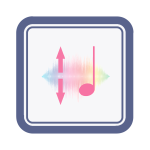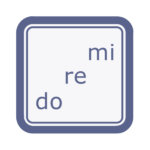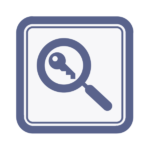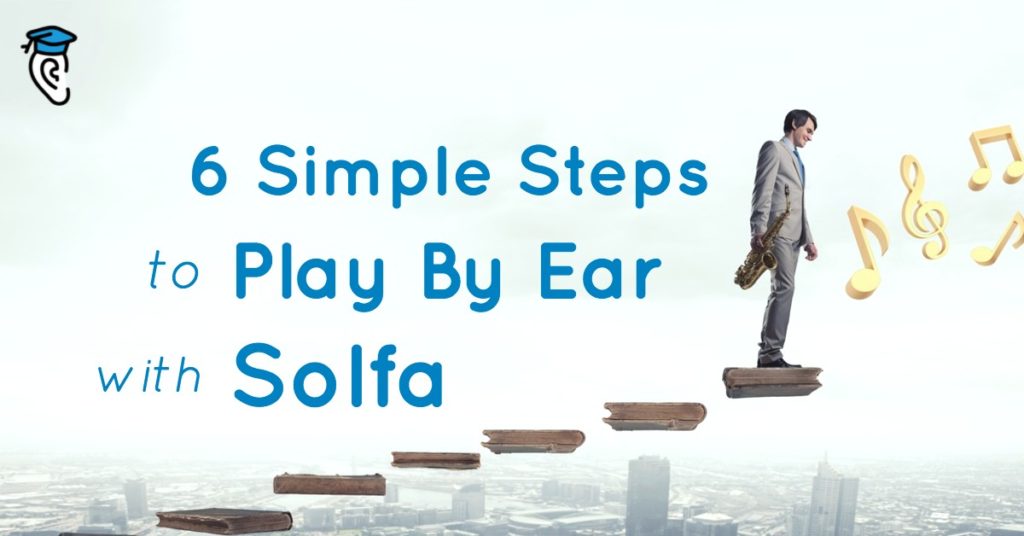Playing music by ear can seem mysterious. Some musicians can do it, most musicians can’t. If you want to learn, wouldn’t it be great if there was actually a clear and logical process to it, rather than seeming like a magic trick? The good news: there is! Solfa is a system you can learn for quickly and reliably identifying the notes in music, allowing you to play by ear on your instrument.
As powerful as solfa is, it is often misunderstood. There are a variety of different names for it, and actually some quite different systems all referred to as “solfa” or “solfège”, some of which are not very useful for playing by ear.
If your goal is to play melodies by ear using solfa, you want to make sure you have a clear and reliable plan to follow which will ensure that your solfa ear training is leading you steadily towards that goal in a fun, interesting and ultimately satisfying way.
Playing music by ear is a major focus at Musical U and since solfa is such an effective framework for playing by ear it comes as no surprise that they have a dedicated “Roadmap” to show you the way. Let’s take a look at the 6 steps of this roadmap and how they help you learn to play by ear with solfa.
Before we get into the details though, let’s clear up a few things.
What is Solfa?
Solfa, also known as solfège or solfeggio, is a framework for relative pitch, which is your ability to judge the distance in pitch between notes.
A well-trained sense of relative pitch is what allows musicians to play by ear, improvise and transcribe music easily, by recognising the relationships between the notes and chords they hear.
There are two main approaches to relative pitch ear training:
- Intervals
- Solfa
You can learn about the interval approach in our Ultimate Guide to Interval Ear Training. It isn’t “either/or” – you can also combine intervals and solfa training to learn faster.
 We refer to the solfa approach as a “framework” because this is really what it gives you: a clear mental structure for music so that the notes you hear just “slot into place” in your mind. You learn to hear the musical role of each note of the scale, so that when you hear those notes in action it’s easy to recognise them and so make sense of the music. This makes it easy to then play the notes by ear on your instrument, improvise your own music that fits in, or write down the notes you’ve heard.
We refer to the solfa approach as a “framework” because this is really what it gives you: a clear mental structure for music so that the notes you hear just “slot into place” in your mind. You learn to hear the musical role of each note of the scale, so that when you hear those notes in action it’s easy to recognise them and so make sense of the music. This makes it easy to then play the notes by ear on your instrument, improvise your own music that fits in, or write down the notes you’ve heard.
The solfa framework involves naming each note in the scale, and you may have heard of it by these names: “do”, “re”, “mi”, and so on. This makes it easier for you to learn the musical role of each note, associating it with the name and giving that name a kind of “musical identity”.
Benefits of learning solfa
Learning solfa has many benefits for a musician. In fact solfa can help you with all these common musical activities:
- Playing melodies by ear, by recognising the notes.
- Playing chords by ear, including common and more unusual chord progressions.
- Transcribing music (writing down music).
- Transposing music (changing key).
- Sight-singing from notation, making it easy to join choirs or learn new repertoire.
- Singing confidently, due to accurate vocal control.
- Improvising freely, knowing the notes you play are the ones you intended.
- Composing and writing songs freely, bringing the music in your head out into the world.
- Making music theory enjoyable and exciting, because it all has much more musical meaning to you.
In this article we’re going to focus just on the first one: playing melodies by ear.
By “melody” we mean the “tune” of a piece of music, a series of notes played one at a time. And by “play by ear” we mean you hear the music (or remember it) and then you can play it back on your instrument. Of course this is very closely related to improvisation (playing by ear what you imagine in your head) and transcription (writing the notes down instead of playing them on your instrument).
Solfa vs. Solfège vs. Solfeggio
A quick clarification before we continue. You might have heard of solfa referred to by two other names, solfège and solfeggio. Is there a difference?
The short answer is yes, but it’s a bit subtle.
First up: “solfeggio” is simply the Italian equivalent of the French world solfège.
“Solfège” is a term which actually covers two very different systems of note naming:
- “Fixed Do”, in which each of the 12 notes in music has a set name, always the same. In the most common system, “Do” is equivalent to the note normally called “C”, no matter what key you are working in. The names “do”, “re”, “mi” etc. can be seen as simple substitutes for the normal note names “C”, “D”, “E”, etc. The advantage is that they are more easily singable!
- “Movable Do”, in which the names of the notes are based on the scale/key. In the most common system, “Tonic Solfa”, the “do” name is always used for the tonic (first) note of the scale. So in C Major, “do” would be “C”. In F Major, “do” would be F. This means that the names correspond to the musical role of each note in a given piece, as we discussed earlier.
There are debates among music educators over which system is best, but movable do is more popular and most musicians agree that it is the more practical and useful system for tasks like playing by ear or improvisation.
At Easy Ear Training and Musical U we focus on movable do, and for that reason we tend to use the word “solfa”. Although this word is used interchangeably with “solfège” and can be ambiguous, it is normally associated with the system “tonia solfa” system mentioned above.
So “solfa” is roughly a shorthand of “movable do solfège”.
All clear? Good! Let’s dig in to how you can learn solfa and use it to play melodies by ear.
How to use Solfa to play melodies by ear
To learn solfa, you use a combination of listening exercises and singing exercises. Don’t worry if you don’t consider yourself a singer! You can use our free guide to learn to sing in tune and that’s all you need to be able to do.
The goal is to learn to recognise and reproduce each of the notes of the scale by their solfa names.
You can begin simply, by just learning the first few notes, “do”, “re” and “mi”. Listening exercises train your ears to spot which of those three notes you’ve heard. Singing exercises train you to reproduce each of the three notes for a given “do”.
 Gradually you build up your knowledge of the solfa for the full major and minor scales. At Musical U and in the SingTrue app we use the major pentatonic as a stepping stone towards the full major scale which provides an easy and effective way to learn solfa gradually.
Gradually you build up your knowledge of the solfa for the full major and minor scales. At Musical U and in the SingTrue app we use the major pentatonic as a stepping stone towards the full major scale which provides an easy and effective way to learn solfa gradually.
Once you can reliably and instinctively recognise and reproduce the solfa notes, you can apply this skill to all of the benefits listed earlier, including playing melodies by ear. In fact, you’ll find you can’t help doing it! When you hear music you will start to instinctively know the identities of the notes, e.g. “Oh, that tune went ‘mi mi re re do'”.
What once would have seemed like some kind of magic becomes easy and natural because you’ve learned to recognise the musical role of each note.
Let’s look at this process in more detail, based on the Roadmap for playing melodies by ear using solfa, from Musical U. First though, what exactly do we mean by “Roadmap”?
What is a Roadmap?
Roadmaps are designed to give you clarity about your musical training. When you start with a big goal like learning to play melodies by ear it can be inspiring, but you’re then left to try to figure out all the details of actually making it happen!
 At Musical U you get access to a fully flexible training system featuring dozens of training modules which you can perfectly combine to suit your needs. To help you use it all effectively there is also a set of Roadmaps, each for developing an important musical skill.
At Musical U you get access to a fully flexible training system featuring dozens of training modules which you can perfectly combine to suit your needs. To help you use it all effectively there is also a set of Roadmaps, each for developing an important musical skill.
Each Roadmap is designed to answer three questions:
- Where am I?
- Where do I want to go?
- How will I get there?
The Roadmap isn’t itself a training plan but after reading through it (including just the free preview version linked below) you should have a clear answer to each of the questions above so that you can then create your real training plan.
→ Learn more about ear training roadmaps
Solfa Roadmap Overview
The Musical U Roadmap for Playing Melodies By Ear With Solfa is broken down into 6 phases. These lead you from zero ability with solfa through to confidently playing simple melodies by ear on your instrument.
The Roadmap features “Learn” modules which explain the essential concepts, “Practice” modules which train your core skills, and additional exercises you can use to improve your skills and apply them on your instrument.
Phases 1 and 2: Fundamentals and Solfa Preparation
Solfa is a framework for relative pitch, and so before you begin solfa ear training it’s valuable to spend some time getting clear on the main concepts around pitch and relative pitch. With two Ear Expansion modules you get a mix of information, listening examples and interactive tests to explore these two topics in a fun and useful way.
 Then it’s time to dig into what solfa is and how it works. As covered earlier, solfa and interval ear training are closely related. Indeed, many musicians use solfa specifically as a way to learn interval recognition, or vice-versa. The Learning Intervals module explains all about the relationship between these two and how each can help you with the other as you develop your sense of relative pitch.
Then it’s time to dig into what solfa is and how it works. As covered earlier, solfa and interval ear training are closely related. Indeed, many musicians use solfa specifically as a way to learn interval recognition, or vice-versa. The Learning Intervals module explains all about the relationship between these two and how each can help you with the other as you develop your sense of relative pitch.
 Then the Start Solfa module explains solfa step-by-step and gives you some handy exercises to begin training your ears for solfa note recognition through singing. The Roadmap gives guidance on using these exercises daily to establish your solfa foundation.
Then the Start Solfa module explains solfa step-by-step and gives you some handy exercises to begin training your ears for solfa note recognition through singing. The Roadmap gives guidance on using these exercises daily to establish your solfa foundation.
Phase 3: Start Learning Solfa!
With the basics under your belt, you can begin solfa ear training in earnest. The Roadmap gives two options in this phase. You can use the Interval Recognition module inside Musical U, or the companion SingTrue iOS app.
Both options provide you with a sequence of lessons for learning to recognise each solfa scale degree in turn, beginning with just a few notes and extending to the full major pentatonic scale.
 Already in this phase you can begin practicing playing melodies by ear on your instrument, and the Roadmap provides a simple exercise to combine solfa practice with instrument playback. Solfa is also a great tool for improvising, and sung improvisation is a fun way to practice solfa. You’ll find a cool solfa improvisation singing exercise in this phase too, so that your daily solfa ear training can be varied and continually interesting.
Already in this phase you can begin practicing playing melodies by ear on your instrument, and the Roadmap provides a simple exercise to combine solfa practice with instrument playback. Solfa is also a great tool for improvising, and sung improvisation is a fun way to practice solfa. You’ll find a cool solfa improvisation singing exercise in this phase too, so that your daily solfa ear training can be varied and continually interesting.
Phase 4: Playing By Ear Preparation
You’ve begun to connect solfa practice with your instrument, but before continuing to really playing melodies by ear there are a few extra things to cover.
First of all, playing by ear is a topic immersed in myths and misunderstandings. The Start Playing By Ear module will reveal the simple truth and strategies which help you learn this skill in a practical way. Then the Play-By-Ear Process module shows you what playing by ear looks like in reality, in depth, with pop and rock examples.
 As noted earlier on, tonic solfa uses the first note of the scale as “do”. This means that to translate “do, re, mi” etc. into note names to play you your instrument (e.g. “C, D, E” or “G, A, B”) you need one more thing: to know what key you are in. That’s why in this phase the Roadmap features the Finding the Key module which teaches you a reliable 4-step process for identifying the key of a song by ear.
As noted earlier on, tonic solfa uses the first note of the scale as “do”. This means that to translate “do, re, mi” etc. into note names to play you your instrument (e.g. “C, D, E” or “G, A, B”) you need one more thing: to know what key you are in. That’s why in this phase the Roadmap features the Finding the Key module which teaches you a reliable 4-step process for identifying the key of a song by ear.
Phases 5 and 6: Playing Melodies By Ear
Armed with your new understanding of how playing by ear works, a well-trained solfa framework in your head, and an ability to identify the key of a song by ear, you are ready! It’s time to start playing melodies by ear.
 In Phases 5 and 6 you use the Melody Practice: Major Pentatonic module along with some fun instrument exercises to gradually start playing longer, more complex and more varied melodies by ear.
In Phases 5 and 6 you use the Melody Practice: Major Pentatonic module along with some fun instrument exercises to gradually start playing longer, more complex and more varied melodies by ear.
By the end of Phase 6 you’re playing long melodies using the full major pentatonic scale in a variety of keys on your instrument. You’re also improvising complex sung melodies and playing them back on your instrument for further play-by-ear practice.
There’s more beyond this, including the full major and minor scales – but you’ve now gone from zero to playing real musical melodies by ear easily and instinctively on your instrument. Awesome!
Playing By Ear with Solfa
For many musicians, playing by ear can seem like a magical skill. However, as we’ve seen, solfa can provide you with a clear and logical mental framework which makes it easy to recognise the “musical role” of each note, and so identify them in a melody and play them back on your instrument.
Learning solfa won’t happen overnight, but with 6-8 weeks practice using a process like the Roadmap described above, you can develop a solid ability which is useful in your day-to-day musical life. Playing by ear, improvising, and creating your own music are all within your reach when you have a roadmap for learning solfa!
→ See the full Play Melodies By Ear (Solfa) Roadmap








